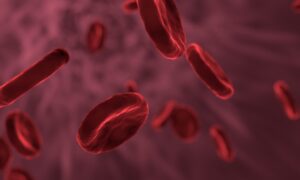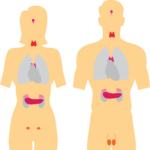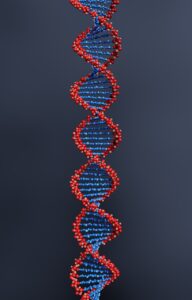 Hemoglobinopathies are unique amongst all genetic diseases because the identification of healthy carriers is possible by commonly available blood tests – blood count, osmotic fragility, hemoglobin profile (first line tests) and molecular analysis is not required. If any abnormal hemoglobin fraction appears, functional tests are applied to determine with a pretty good degree of reliability the type of pathological hemoglobin and its clinical significance, avoiding the usage of expensive molecular methods. Confirmation of gene mutations presence with molecular techniques is only necessary in small number of cases – in so-called “couples at risk” for the purpose of prevention of thalassemia major, for prenatal or pre-implantation diagnosis – when both parents are thalassemia carriers (or suspected carriers), or carriers of clinically significant hemoglobin variant.
Hemoglobinopathies are unique amongst all genetic diseases because the identification of healthy carriers is possible by commonly available blood tests – blood count, osmotic fragility, hemoglobin profile (first line tests) and molecular analysis is not required. If any abnormal hemoglobin fraction appears, functional tests are applied to determine with a pretty good degree of reliability the type of pathological hemoglobin and its clinical significance, avoiding the usage of expensive molecular methods. Confirmation of gene mutations presence with molecular techniques is only necessary in small number of cases – in so-called “couples at risk” for the purpose of prevention of thalassemia major, for prenatal or pre-implantation diagnosis – when both parents are thalassemia carriers (or suspected carriers), or carriers of clinically significant hemoglobin variant.
By comparison and evaluation of the results of relevant blood tests, the patient’s history, and considering additional factors, the proper diagnosis of hemoglobinopathies with non-molecular methods is crucial for the prevention of a childbirth with a severe diagnosis. Read the full article here.

 Factor XII deficiency is rare bleeding disorder and theoretically may carry either bleeding risk as a result of reduced coagulation factors or thrombosis risk as a consequence of reduced fibrinolytic activity. The incidence of factor XII deficiency is relatively low at 1 in 1,000,000 people.
Factor XII deficiency is rare bleeding disorder and theoretically may carry either bleeding risk as a result of reduced coagulation factors or thrombosis risk as a consequence of reduced fibrinolytic activity. The incidence of factor XII deficiency is relatively low at 1 in 1,000,000 people. Immune thrombocytopenia is a rare autoimmune disease. This is a diagnosis by the process of elimination. In children the disease is characterized by a sudden decrease in platelet count, with only 50% to 60% of patients having detectable anti-platelet antibodies in peripheral blood. The pathogenesis is heterogeneous, and the diagnosis is complex.
Immune thrombocytopenia is a rare autoimmune disease. This is a diagnosis by the process of elimination. In children the disease is characterized by a sudden decrease in platelet count, with only 50% to 60% of patients having detectable anti-platelet antibodies in peripheral blood. The pathogenesis is heterogeneous, and the diagnosis is complex. Haemophilia is a genetic disease with an X-linked recessive inheritance. It is a bleeding disorder that affects mainly males. There are two types of haemophilia, depending on the affected gene – haemophilia A (F8 gene) and haemophilia B (F9 gene). According to the coagulation levels of factor VIII/IX, haemophilia can be mild (5–40%), moderate (1–5%), or severe (less than 1%).
Haemophilia is a genetic disease with an X-linked recessive inheritance. It is a bleeding disorder that affects mainly males. There are two types of haemophilia, depending on the affected gene – haemophilia A (F8 gene) and haemophilia B (F9 gene). According to the coagulation levels of factor VIII/IX, haemophilia can be mild (5–40%), moderate (1–5%), or severe (less than 1%). Beta-thalassemia is one of the most common autosomal-recessive disorders. The advances in the chelator treatment and the non-invasive methods for the assessment and follow up of the iron overload have led to an improved quality and longer duration of the life of patients with thalassemia. The liver is the primer target organ affected both directly and indirectly. In this article are reviewed the most common liver complications such as liver fibrosis and cirrhosis, non-invasive methods for evaluation of the iron deposition, chronic viral hepatitis, hepatocellular carcinoma and cholelithiasis. Read the full article
Beta-thalassemia is one of the most common autosomal-recessive disorders. The advances in the chelator treatment and the non-invasive methods for the assessment and follow up of the iron overload have led to an improved quality and longer duration of the life of patients with thalassemia. The liver is the primer target organ affected both directly and indirectly. In this article are reviewed the most common liver complications such as liver fibrosis and cirrhosis, non-invasive methods for evaluation of the iron deposition, chronic viral hepatitis, hepatocellular carcinoma and cholelithiasis. Read the full article  Ralitsa Raycheva, Kostadin Kostadinov, Elena Mitova, Nataliya Bogoeva, Georgi Iskrov, Georgi Stefanov, and Rumen Stefanov, affiliated with Institute for Rare Disease and Department of Social Medicine and Public Health at the Medical University of Plovdiv, аre actively contributing to the Screen4Care project, which started in 2021. This project is dedicated to addressing the challenge of expediting the diagnosis of rare diseases, with particular focus on genetic newborn screening and digital technologies.
Ralitsa Raycheva, Kostadin Kostadinov, Elena Mitova, Nataliya Bogoeva, Georgi Iskrov, Georgi Stefanov, and Rumen Stefanov, affiliated with Institute for Rare Disease and Department of Social Medicine and Public Health at the Medical University of Plovdiv, аre actively contributing to the Screen4Care project, which started in 2021. This project is dedicated to addressing the challenge of expediting the diagnosis of rare diseases, with particular focus on genetic newborn screening and digital technologies.

 Acromegaly is a rare disease, usually caused by a pituitary tumor. It typically exhibits slow evolution and can result in numerous complications. In the present case report, the patient presents with hyperthyroidism associated with ophthalmopathy and right nodular goiter. The laboratory tests reveal persistent high levels of phosphorus without an apparent cause. After ruling out common pathologies associated with this finding, a focus ia placed on the clinical aspects associated with acromegaly, a rare cause of hyperphosphatemia. Laboratory tests and MRI confirm the diagnosis. This case highlights the challenges in diagnosing and managing a rare endocrine pathology. Read the full article
Acromegaly is a rare disease, usually caused by a pituitary tumor. It typically exhibits slow evolution and can result in numerous complications. In the present case report, the patient presents with hyperthyroidism associated with ophthalmopathy and right nodular goiter. The laboratory tests reveal persistent high levels of phosphorus without an apparent cause. After ruling out common pathologies associated with this finding, a focus ia placed on the clinical aspects associated with acromegaly, a rare cause of hyperphosphatemia. Laboratory tests and MRI confirm the diagnosis. This case highlights the challenges in diagnosing and managing a rare endocrine pathology. Read the full article  Hereditary hemorrhagic telangiectasia (HHT) is a rare vascular disease inherited in an autosomal dominant manner. Disease-causing variants in endoglin (ENG) and activin A receptor type II-like 1 (ACVRL1) genes are detected in around 90% of the patients; also 2% of patients harbor pathogenic variants at SMAD4 and GDF2. Importantly, the genetic cause of 8% of patients with clinical HHT remains unknown.
Hereditary hemorrhagic telangiectasia (HHT) is a rare vascular disease inherited in an autosomal dominant manner. Disease-causing variants in endoglin (ENG) and activin A receptor type II-like 1 (ACVRL1) genes are detected in around 90% of the patients; also 2% of patients harbor pathogenic variants at SMAD4 and GDF2. Importantly, the genetic cause of 8% of patients with clinical HHT remains unknown. Estimates of rare disease (RD) population impact in terms of number of affected patients and accurate disease definition is hampered by their under-representation in current coding systems. This study tests the use of a specific RD codification system (ORPHAcodes) in five European countries over the period January 2019-September 2021.
Estimates of rare disease (RD) population impact in terms of number of affected patients and accurate disease definition is hampered by their under-representation in current coding systems. This study tests the use of a specific RD codification system (ORPHAcodes) in five European countries over the period January 2019-September 2021.